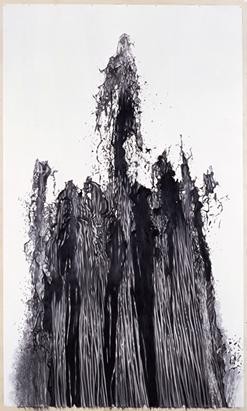Marc Brandenburg
29 Nov 2008 - 03 Jan 2009
MARC BRANDENBURG
"Vomit, Form And Fictitious Movement"
Galerie Thaddaeus Ropac is pleased to announce an exhibition by the emerging Berlin artist, Marc Brandenburg, which will include 18 new drawings of various sizes.
At first glance, Brandenburg's delicate pencil drawings seem like negatives of snapshots from a bizarre parallel world. His photo-realistic scenes of demonstrators, flag-waving football fans, clowns, fairgrounds, portraits of friends and relatives, fountains and over-inflated Christmas decorations have a menacing effect. The silvery, shiny texture of the graphite surfaces is combined with finely nuanced, tapering contours. Everything is bathed in an ethereal light. The methods, practices, and techniques that Brandenburg employs are evident in his trademark black-and-white drawings.
With regards to the tension and energy in his drawings, Diedrich Diederichsen writes in his catalogue essay, that "Brandenburg's drawings are executed in the style of spiritual exercises...On the one hand, this pressure, the ecstasy of production, is superfluous, because it cannot be seen by looking at the drawings; on the other hand, it is their conditio sine qua non. While artists like On Kawara depict their working method as a spiritual exercise, Brandenburg does the opposite: he produces something that seemingly has nothing to do with the working method, but can only be explained and described with reference to it."
Many of the drawings deal with situations that could potentially lead to a loss of control: sexuality, football hooligans, ravers, hordes of people, as well as physical exertion, excess, vomit. Excess and extreme definition and contours are juxtaposed against one another. This creates a sense of serenity around which the excess revolves. The drawings deal with form, and it's limitations. They address the balance and draw parallels between control and loss of control, form and formlessness.
Born in Berlin in 1965, Brandenburg grew up in Texas and Germany. In the early 1990s he shot to fame with his forceful graphite drawings, and within a very short time he rose to the top league of the young German art scene. His works are included in collections such as that of the Museum of Modern Art in New York, the Kupferstichkabinett Berlin, the Hamburger Kunsthalle, and the Museum of Modern Art Frankfurt.
"Vomit, Form And Fictitious Movement"
Galerie Thaddaeus Ropac is pleased to announce an exhibition by the emerging Berlin artist, Marc Brandenburg, which will include 18 new drawings of various sizes.
At first glance, Brandenburg's delicate pencil drawings seem like negatives of snapshots from a bizarre parallel world. His photo-realistic scenes of demonstrators, flag-waving football fans, clowns, fairgrounds, portraits of friends and relatives, fountains and over-inflated Christmas decorations have a menacing effect. The silvery, shiny texture of the graphite surfaces is combined with finely nuanced, tapering contours. Everything is bathed in an ethereal light. The methods, practices, and techniques that Brandenburg employs are evident in his trademark black-and-white drawings.
With regards to the tension and energy in his drawings, Diedrich Diederichsen writes in his catalogue essay, that "Brandenburg's drawings are executed in the style of spiritual exercises...On the one hand, this pressure, the ecstasy of production, is superfluous, because it cannot be seen by looking at the drawings; on the other hand, it is their conditio sine qua non. While artists like On Kawara depict their working method as a spiritual exercise, Brandenburg does the opposite: he produces something that seemingly has nothing to do with the working method, but can only be explained and described with reference to it."
Many of the drawings deal with situations that could potentially lead to a loss of control: sexuality, football hooligans, ravers, hordes of people, as well as physical exertion, excess, vomit. Excess and extreme definition and contours are juxtaposed against one another. This creates a sense of serenity around which the excess revolves. The drawings deal with form, and it's limitations. They address the balance and draw parallels between control and loss of control, form and formlessness.
Born in Berlin in 1965, Brandenburg grew up in Texas and Germany. In the early 1990s he shot to fame with his forceful graphite drawings, and within a very short time he rose to the top league of the young German art scene. His works are included in collections such as that of the Museum of Modern Art in New York, the Kupferstichkabinett Berlin, the Hamburger Kunsthalle, and the Museum of Modern Art Frankfurt.

